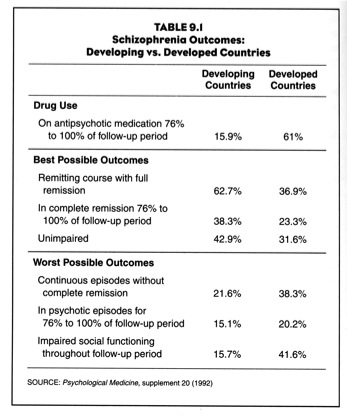Schizophrenia: Manifestations, Incidence and Course in Different Cultures.Jablensky, A. Psychological Medicine, supplement 20 (1992):1-95.
The second WHO study was called the Determinants of Outcome of Severe Mental Disorders. It involved 1379 patients from 10 countries, and was designed as a follow-up study to the International Pilot Study of Schizophrenia. The patients in this study were first-episode patients, and 86% had been ill fewer than 12 months. This study confirmed the findings of the first: two-year outcomes were much better for the patients in the poor countries. In broad terms, 37 percent of the patients in the poor countries (India, Nigeria and Colombia) had a single psychotic episode and then fully recovered; another 26.7% of the patients in the poor countries had two or more psychotic episodes but still were in “complete remission” at the end of the two years. In other words, 63.7% of the patients in the poor countries were doing fairly well at the end of two years. In contrast, only 36.9% of the patients in the U.S. and six other developed countries were doing fairly well at the end of two years. The researchers concluded that “being in a developed country was a strong predictor of not attaining a complete remission.”
Although the WHO researchers didn’t identify a variable that would explain this difference in outcomes, they did note that in the developing countries, only 15.9% of patients were continuously maintained on neuroleptics, compared to 61% of patients in the U.S. and other developed countries.
Who Data Summarized












